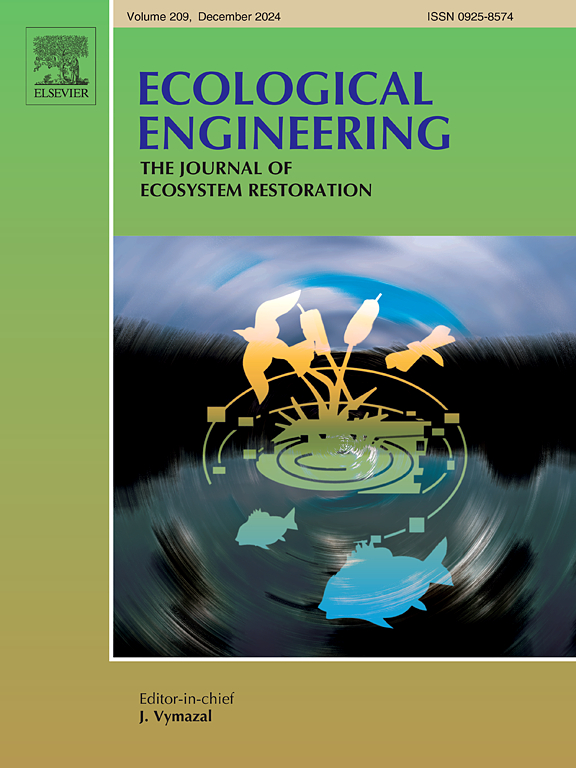Seasonal variation and influencing factors of gas emission from free water surface flow constructed wetlands
IF 4.1
2区 环境科学与生态学
Q1 ECOLOGY
引用次数: 0
Abstract
Orthogonal experiments were conducted to investigate the gas emission patterns of free water surface flow constructed wetlands (FWS CWs). The correlation between the emission fluxes of four wetland gases—ammonia (NH3), carbon dioxide (CO2), methane (CH4), and nitrous oxide (N2O)—and several characteristics, including design parameter, hydraulic performance, purification effect, soil nutrients, and microbial communities were analyzed. The results indicated that gas emission fluxes were significantly higher in the warm seasons than in the cold season. In warm seasons, water depth and inflow total nitrogen (TN) concentration emerged as the most crucial design parameters influencing CO2 and CH4 emissions, and NH3 and N2O emissions, respectively. Higher water depth effectively reduced gas emission, as well as hydraulic and treatment performance. Furthermore, gas emission fluxes exhibited positive correlations with hydraulic performance and negative correlations with nitrogen removal. The emission fluxes of CO2 and CH4 demonstrated significant positive correlations with the soil carbon to nitrogen ratio in cold season. However, there was no consistent significant correlation between gas emissions and soil microbes. The relative abundance of Nitrospirota showed moderate to significant inhibitory effects on CH4 emissions in warm seasons, while that of Planctomycetota exhibited significant positive correlations with NH3 and CH4 emissions in early winter. This study highlighted the seasonal variations in gas emissions influenced by multiple factors, underscored the complexities involved in selecting design parameters for optimal wetland performance, and pointed out the challenges in achieving multi-objective optimization of FWS CWs.

自由水面流人工湿地气体排放的季节变化及影响因素
采用正交试验研究了自由水面流人工湿地(FWS CWs)气体排放规律。分析了氨(NH3)、二氧化碳(CO2)、甲烷(CH4)和氧化亚氮(N2O) 4种湿地气体排放通量与设计参数、水力性能、净化效果、土壤养分和微生物群落等特征的相关性。结果表明:暖季气体排放通量明显高于冷季;在暖季,水深和入流总氮(TN)浓度分别成为影响CO2和CH4排放、NH3和N2O排放的最关键设计参数。较高的水深有效地降低了气体排放,改善了水力和处理性能。此外,气体排放通量与水力性能呈正相关,与氮去除呈负相关。寒季CO2和CH4排放通量与土壤碳氮比呈显著正相关。然而,气体排放与土壤微生物之间没有一致的显著相关性。亚硝酸螺旋藻的相对丰度在暖季对CH4的排放表现出中等到显著的抑制作用,而植物菌的相对丰度在初冬对NH3和CH4的排放表现出显著的正相关。本研究强调了受多种因素影响的气体排放的季节性变化,强调了选择最佳湿地性能设计参数的复杂性,并指出了实现FWS化粪池多目标优化的挑战。
本文章由计算机程序翻译,如有差异,请以英文原文为准。
求助全文
约1分钟内获得全文
求助全文
来源期刊

Ecological Engineering
环境科学-工程:环境
CiteScore
8.00
自引率
5.30%
发文量
293
审稿时长
57 days
期刊介绍:
Ecological engineering has been defined as the design of ecosystems for the mutual benefit of humans and nature. The journal is meant for ecologists who, because of their research interests or occupation, are involved in designing, monitoring, or restoring ecosystems, and can serve as a bridge between ecologists and engineers.
Specific topics covered in the journal include: habitat reconstruction; ecotechnology; synthetic ecology; bioengineering; restoration ecology; ecology conservation; ecosystem rehabilitation; stream and river restoration; reclamation ecology; non-renewable resource conservation. Descriptions of specific applications of ecological engineering are acceptable only when situated within context of adding novelty to current research and emphasizing ecosystem restoration. We do not accept purely descriptive reports on ecosystem structures (such as vegetation surveys), purely physical assessment of materials that can be used for ecological restoration, small-model studies carried out in the laboratory or greenhouse with artificial (waste)water or crop studies, or case studies on conventional wastewater treatment and eutrophication that do not offer an ecosystem restoration approach within the paper.
 求助内容:
求助内容: 应助结果提醒方式:
应助结果提醒方式:


